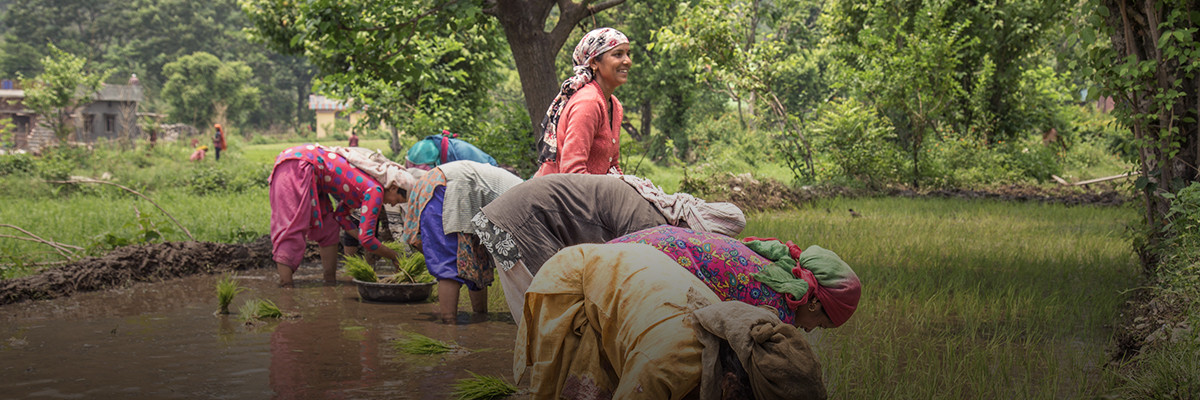
Authors
-
Samantha Harris
Former Associate Director, BSR
-
Katie Abbott
Former Manager, Inclusive Economy, BSR
The intersection of climate change and women, although rarely prioritized in decision-making or solutions, is not a new concept. But, as Mary Robinson said, “If we took away the barriers to women’s leadership, we would solve the climate change problem a lot faster.”
As Mary Robinson said, “If we took away the barriers to women’s leadership, we would solve the climate change problem a lot faster.”
In 2015, the international arena formally gave this women-climate nexus a platform within the Paris Agreement and the Sustainable Development Goals (SDGs). In 2017, UNFCCC countries adopted the Gender Action Plan at the climate negotiations. These international frameworks now recognize the intersection between gender inequality and climate change, as well as the need for the integration of women’s voices, skills, and knowledge in solutions. It is time for businesses to act by empowering women leaders to take climate action throughout their value chains.
Today, we are excited to launch a new report that highlights tangible ways of doing this. Companies can address climate risk more effectively and efficiently if they put women at the heart of their climate resilience strategies.
Women are disproportionately affected by climate change—not because they experience more climate impacts than men, but because women face underlying socioeconomic, political, and legal barriers that limit their choices in the face of climate change. Climate impacts exacerbate these barriers and ultimately hinder climate resilience activities from reaching their full potential.
For example, only 47 percent of women have an account at a formal financial institution, compared to 55 percent of men. Without bank accounts and financial resources, women cannot easily diversify their livelihoods or access financial capital before and after climate disasters. Additional barriers include norms related to unpaid work, limited access to income, discriminatory laws, land ownership restrictions, a lack of capacity-building resources, and a lack of voice. These barriers not only limit the adaptive capacity of women to climate impacts, but they also influence the adaptive capacity of communities and company value chains—in particular, agriculture (nearly 50 percent of smallholder farmers in some countries are women) and apparel (nearly 80 percent of apparel factory workers are women).
Despite these deeply rooted barriers, women possess unique and key skills, knowledge, and experiences critical for climate resilience solutions, making them powerful change agents. For example, women make different choices than men that can help an agricultural community within a value chain thrive and adapt to climate change. For generations, women have been land stewards and have maintained local climate, plant, and seed-planting knowledge. This makes them natural targets for involvement in the creation and use of climate adaptation tools and trainings, in particular as men continue to move to more non-farm jobs and climate impacts continue to worsen.
Climate resilience solutions with a specific focus on women are a win-win: They tackle climate risk and gender inequality simultaneously, with clear benefits for business, women, and communities. For businesses, empowering women and also making them leaders in the development and implementation of these solutions can drive productivity and innovation, especially within sectors like agriculture and apparel that depend heavily on a female workforce. Companies can also protect raw materials, increase financial stability and returns, strengthen the resilience of local communities, and deliver other co-benefits, like stabilizing livelihoods, improving food security, and making progress toward closing the global gender gap, as part of this approach.
Businesses that recognize this can play an important role in developing these solutions within their own operations, and they can also collaborate with others to make progress. More specifically, they can:
- Act to put women at the center of all internal climate resilience approaches and solutions. In particular, companies can provide women in supply chains access to relevant trainings, inputs, financing, and technologies.
- Enable women throughout the value chain and broader community to effectively respond to climate-related events by linking them with local networks and partners, which can serve as mutual support mechanisms to strengthen climate resilience.
- Influence policymakers and other organizations to help address underlying inequalities, such as the lack of decision-making power of women, which are particularly challenging in the context of a changing climate.
Through the Business Action for Women collaboration, BSR works with leading companies on climate change, including Mars, L’Oreal, and Coca-Cola, to share best practices and collectively develop innovative solutions that empower women to lead on climate resilience in agricultural supply chains from the ground up.
Real transformation for both climate resilience and gender equality will happen when companies tackle the structural and systemic barriers women face and involve women in solutions—putting women at the center of their climate strategies.
BSR’s climate and women nexus report is the fourth in our series, which also includes reports on the intersection between climate and supply chains, health, and inclusive economy. Stay tuned for more on the connections between climate resilience and human rights and a just transition to the low-carbon economy in the months to come.
Let’s talk about how BSR can help you to transform your business and achieve your sustainability goals.